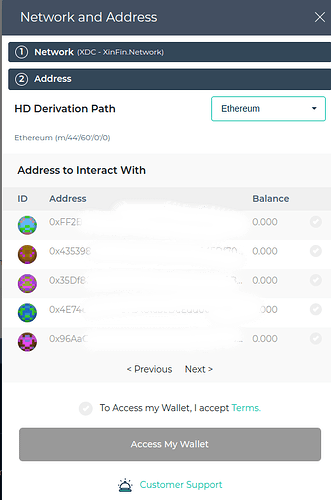Continuing the discussion from [Coins / Wallets Disappeared on New App Install]:
I’m rerencing my other topic it helps anyone (myself for sure) follow my train of thoughts and questions here. My previous thread was my first time hearing about xpubs. I am trying to put this into context of what I have done so far and what else I understand.
In the process of trying to set myself up to receive XDC and mange it through my Trezor wallet, I read this page (https ://trezor .io/coins/detail/xdce-crowd-sale), which led me to creating a wallet here (https ://wallet .xinfin.network/#/). I attempted to set up with an account using the Trezor hardware, but it failed to connect because they are using Trezor Connect V6.
So I created a wallet there instead using the mnemonic phrase. When I was set up I was presented with a screen that said “Address to Interact With” and a list of addresses.
I’ve never seen anything like that before. Up until now I’ve been under the impression a wallet and an address were the same, so please bear with me.
I was reading other topics in this forum and came to the conclusion that I could still use my Trezor to manage the XDC if I created an account on Metamask with the Trezor wallet. I followed these instructions (https ://trezor .io/learn/a/metamask-and-trezor) and again, saw the same thing with multiple accounts listed. I didn’t know what this meant because I’ve only ever seen one in the Trezor Suite.
This answer was in my previous topic:
Looked up what xPubs were; this rang a bell since as a web developer I often work with SSL certificates. I’ve set up a PKI for securing my home network, and am familiar with the Root CA - Intermediate Certificate - Leaf Certificate relationship. It sounds to me like xPubs are very similar to intermediate certificates. The intermediate certificates can sign the final used certs on websites, and if someone trusts the Root CA then the certificate is accepted.
Is this analogy proper? Is an extended public key like an intermediate certificate, able to create child public keys which are a 1:1 association with an address? So, when securing my home network, I create the Root Private / Public Key pair to create the CA, then an intermediate certificate, then individual SSL certificates for websites from the intermediate one. And, my Trezor hardware wallet has created a “root” Private / Public Key pair, then an xPub, which creates more public keys associated with individual addresses?
